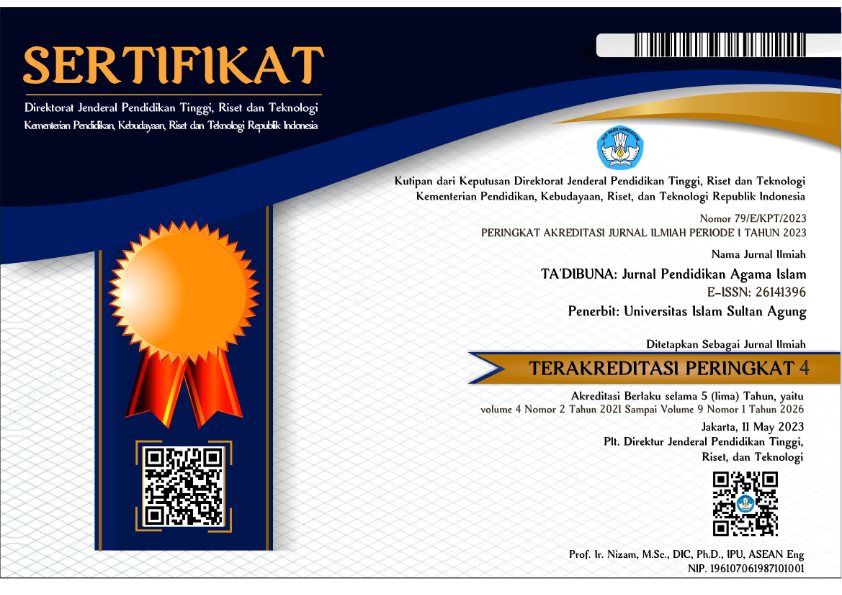Transformasi Pengembangan Bahan Ajar PAI Berbasis Digital dan Vak Method Dalam Meningkatkan Kognitif Siswa
Abstract
Keywords
Full Text:
PDFReferences
Agustini, Aas. (2021). “Strategies of Islamic Religious Education Teachers in the Development of Teaching Materials.†Al-Hayat: Journal of Islamic Education 5(2): 206–15.
Alanbaei, Hebah, Maha H Faisal, and Asmaa A Alsumait. (2018). “VAK Personalized Learner-Sourced E-Notes.†In 2018 International Conference on Computing Sciences and Engineering (ICCSE), IEEE, 1–5.
Aliff Nawi, Gamal, Norkhairiah, Chua Chay Ren. (2020). “The Needs of Islamic Digital Resources in Polytechnic Brunei Darussalam :†13(1): 225–34.
Amalia, Aal, and Wisnawati Loeis. (2020). “KREATIVITAS GURU PAI DALAM MENINGKATKAN KOGNITIF SISWA (Studi Kualitatif Naturalistik Di SMP PGRI Cikarang Utara).†Turats 13(2): 73–82.
Bakar, M Yunus Abu, and Ah Zakki Fuad. (2023). “PENDIDIKAN ISLAM INTEGRATIF MUHAMMAD IQBAL Menguak Tabir Pendidikan Ideal Perpektif Pujangga Fenomenal.†08(02): 1–15.
Bilyalova, A A, D A Salimova, and T I Zelenina. (2020). “Digital Transformation in Education.†In Integrated Science in Digital Age: ICIS 2019, Springer, 265–76.
Bujuri, Dian Andesta. 2018. “Analisis Perkembangan Kognitif Anak Usia Dasar Dan Implikasinya Dalam Kegiatan Belajar Mengajar.†LITERASI (Jurnal Ilmu Pendidikan) 9(1): 37.
El-yunusi, Muhammad Yusron Maulana, and M Yunus Abu Bakar. (2022). “Students ’ Interpersonal Intelligence Formulation ( Case Study at Darussalam Gontor Islamic Boarding School ).â€
Ibda, Fatimah. (2015). “Perkembangan Kognitif: Teori Jean Piaget.†Intelektualita 3(1).
Indira, Noor Meutia. (2022). “Pemanfaatan Bahan Ajar Digital Pada Materi Pendidikan Agama Islam Di SMP Negeri 2 Pemalang.†https://eprints.walisongo.ac.id/.
Junaeti, E, and S Mulya. (2019). “Developing an Interactive Multimedia of Network Topology Based on Visual, Auditory, and Kinaesthetic Learning Model for Vocational Students.†In Journal of Physics: Conference Series, IOP Publishing, 32036.
Khaidir, Eniwati, and Fitriah M. Suud. (2020). “Islamic Education in Developing Students ’ Characters At As-Shofa Islamic High School ,.†Islamic Education in Developing Students’ Characters At As-Shofa Islamic High School, Pekanbaru Riau 1(1): 50–63.
Kusmitasari, Ika. (2017). “APLIKASI HAFALAN AL-QURAN MENGGUNAKAN METODE MURAJA’AH BERBASIS ANDROID (STUDI KASUS PONDOK PESANTREN AN-NURIYYAH MALANG).â€
Laili Mas’udah, M. Yunus Abu Bakar. (2021). “Urgency of Using Islamic Education Learning Module for Students in Learning from Home.†Rabbayani 1(1): 1–6.
Mansir, Firman. (2022). “The Position of Islamic Education According to the National Educational System in Indonesia.†Progresiva : Jurnal Pemikiran dan Pendidikan Islam 11(01): 43–54.
Meida, Elsa Fara. (2022). “Pendidikan Agama Islam Dalam Kerangka Kemajuan Teknologi Digital.†Jurnal Teknologi Pendidikan : Jurnal Penelitian dan Pengembangan Pembelajaran 7(1): 95.
Moh Akviansah, Doni, Warto Warto, and Akhmad Arif Musadad. (2021). “Transformasi Bahan Ajar Sejarah Ke Arah Digital: Optimalisasi Pembelajaran Sejarah Di Era Technology Cybernetic.†In Social, Humanities, and Educational Studies (SHES): Conference Series, , 9–14.
Raja, R, and P Nagasubramani. (2018). “Impact of Modern Technology in Education.†Journal of Applied and Advanced Research 3: 33.
Shoimin, Aris. (2021). “68 Model Pembelajaran Inovatif Dalam Kurikulum 2013.â€
Subandi, Subandi. (2011). “Deskripsi Kualitatif Sebagai Satu
Metode Dalam Penelitian Pertunjukan.†Harmonia journal of arts research and education 11(2): 62082.
Whildan, Lissya. (2021). “Analisis Teori Perkembangan Kognisi Manusia Menurut Jean Piaget.†Permata : Jurnal Pendidikan Agama Islam 2(1): 11.
Yefterson, Ridho Bayu, and Kevin Fallo. (2022). “Analisis Kebutuhan Pengembangan Bahan Ajar Digital Pembelajaran Sejarah Berbasis Aplikasi Android Di Sma.†Jurnal Kronologi 4(1): 392–401.
DOI: https://dx.doi.org/10.30659/jpai.6.1.82-90
Refbacks
- There are currently no refbacks.
Ta’dibuna: Jurnal Pendidikan Agama Islam is published by the Master Program of Islamic Education, Faculty of Islamic Studies, Universitas Islam Sultan Agung (UNISSULA), Indonesia.
Jl. Raya Kaligawe Km. 4, PO BOX 1054/SM, Semarang, Indonesia 50112
Email: jurnaltadibuna@unissula.ac.id








